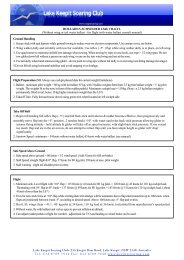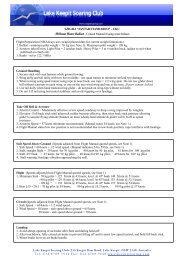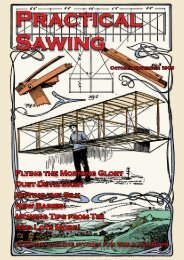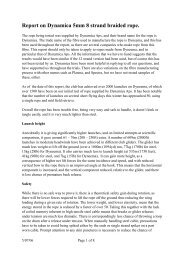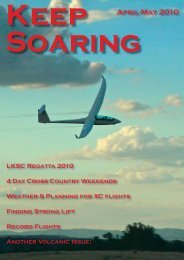Keep Soaring - Lake Keepit Soaring Club
Keep Soaring - Lake Keepit Soaring Club
Keep Soaring - Lake Keepit Soaring Club
You also want an ePaper? Increase the reach of your titles
YUMPU automatically turns print PDFs into web optimized ePapers that Google loves.
of a chain from the GFA MOSP down to the Instructors<br />
panel and to the individual.<br />
If judgement remains poor then fishing is a safer<br />
pastime!<br />
Judgement is not just about flare height or<br />
downwind spacing or choosing a runway. Consider the<br />
big picture; several people are going to attempt to fly to<br />
Narrabri and back. You haven’t flown for a few weeks<br />
and only managed 25 mins then in average conditions.<br />
You had a restless night last night, left home with jobs<br />
undone that your wife wanted done and you feel you<br />
should do this flight to bring everything back together!<br />
Better Judgement would dictate a launch and local<br />
flight to re-hone some basic skills, reset the comfort<br />
zone around the airfield and give the option of landing<br />
at home if concentration lapses. It’s Airmanship really.<br />
The single most critical area of dynamic<br />
judgement is in joining other gliders in a thermal. For<br />
almost all pilots this skill is new. Closure rates, range<br />
assessment, radial movement, height disparity, speed<br />
control and the need to see all the other gliders,<br />
combine to make a high workload and a fair bit of<br />
stress… (a healthy thing here)!<br />
Don’t take it lightly or try it on your own, work up<br />
to it and ask for dual flights when the days are good so<br />
you can get Experience at this critical skill!<br />
3. Responsibility: This can be a touchy subject,<br />
mainly because it’s part of the blame game, modern<br />
social attitudes toward guilt, blame, fault and error lead<br />
to a huge cringe factor! No more George Washingtons<br />
here… deny, litigate, prevaricate, go sick, hide, cry<br />
anything but say “I DID IT”. Bloody poor show I say!<br />
To err is human, to lack skills, judgement or<br />
experience is part of the learning curve. Denial is<br />
avoidance, deceit and cowardice (so there!) What<br />
happened to all our hairy-chested people that could<br />
take it on the chin, so to speak?<br />
Being accountable is fair. Further, it should lead to<br />
reflection on actions before they are carried out… As<br />
you contemplate flying below the windsock or making<br />
3 legs of the circuit from low downwind, think, ”In the<br />
ensuing court of enquiry, was that the best course to<br />
pursue?” Sort of Airmanship, really.<br />
A real positive from honest, considered action in<br />
this area is that a post accident/incident review should<br />
be a learning tool for all; errors reappear, new pilots<br />
come along… Reading about someone else’s problems<br />
leads to gaining Experience from it, improving your<br />
Judgement in that area and should make you think<br />
what you would have done if you were in Command<br />
and exercised sound Airmanship!<br />
If you get something wrong, admit it and ask<br />
for advice on how to avoid it happening again. If it<br />
does happen again ask for help, don’t avoid the issue.<br />
It is the Pilot’s responsibility to have an up to<br />
date log book. The log book must have a current<br />
Annual Flight Review sticker, at <strong>Lake</strong> <strong>Keep</strong>it if the pilot<br />
does not have a log book with them, they don’t fly!<br />
That means you take it to the DI and he checks it! I<br />
Air Experience Instructors, like L1, L2 instructors need to<br />
have that privilege renewed each year by the CFI.<br />
4. Experience: The definition pretty<br />
much says it all. In the early days of learning to fly,<br />
the student generally has to rely on the instructor<br />
to pass on information. With time, interpolation of<br />
outcomes broadens the knowledge. However, well<br />
read enthusiasts and particularly those that have<br />
made and flown model aircraft have an advantage<br />
in understanding aerodynamics. Similarly, listening<br />
to experienced x-country pilots discuss the day’s<br />
challenges and their management of them gives<br />
a database of knowledge that you can try to apply.<br />
Several books on x-country flying are available, some<br />
on line on the GFA site (Flying Faster and Further),<br />
Helmut Reichmann’s Cross Country <strong>Soaring</strong>”” is a well<br />
presented, easy read. If needed he presents technical<br />
details to back up his points.<br />
5. Airmanship: To me, the definition says it<br />
all,<br />
The problem comes with not knowing what you<br />
don’t know! As a guide, if you haven’t done something<br />
and you want to try it, don’t just ask anyone, ask the<br />
instructor present! Most things can be done with care<br />
and training, all GFA endorsed Instructors will be able<br />
to help you, or find someone responsible who can.<br />
On cross-country flights, get well ahead of<br />
the flight, try to look up to 40 or 50 kms ahead for<br />
thermals, gliders, terrain etc. This should make you<br />
aware of landing opportunities well before you get<br />
low.<br />
In a club class glider that distance only means 20 or<br />
so minutes, and things change in that time!<br />
Be aware, look out, listen out, if distracted doing<br />
checks, do them again! Get ahead of the aircraft,<br />
anticipate the problems that you may confront in<br />
<strong>Keep</strong> <strong>Soaring</strong> September - October 2011 Page 31



